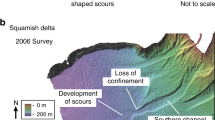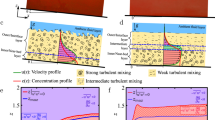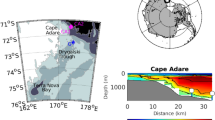Abstract
THE Alaskan Stream, a westward flow along the south side of the Alaska Peninsula and Aleutian Islands, has been known to exist for decades, but its westward extent, true speeds and other details were not generally recognized until much later. Based on observations made in the summer of 1959, Favorite1 described the system and concluded that the Alaskan Stream is a narrow, western boundary current with peak surface speeds exceeding 50 cm/s. An analysis of data obtained by the Scripps Institution of Oceanography in January 1966 and by the Pacific Oceanographic Research Laboratory in September 1966 and 1967 shows that appreciable changes occur in volume transport and width of the Stream.
This is a preview of subscription content, access via your institution
Access options
Subscribe to this journal
Receive 51 print issues and online access
$199.00 per year
only $3.90 per issue
Buy this article
- Purchase on Springer Link
- Instant access to full article PDF
Prices may be subject to local taxes which are calculated during checkout
Similar content being viewed by others
References
Favorite, F., Intern. North Pac. Fish. Comm. Bull., 21 (1967).
Uda, M., Abst. Symp. Pap. Tenth Pacific Science Congress, 345 (1961).
Uda, M., J. Fish. Res. Bd. Canada, 20, 119 (1963).
Dodimead, A. J., Favorite, F., and Hirano, T., Intern. North Pac. Fish. Comm. Bull., 13 (1963).
Author information
Authors and Affiliations
Rights and permissions
About this article
Cite this article
REED, R. Transport of the Alaskan Stream. Nature 220, 681–682 (1968). https://doi.org/10.1038/220681a0
Received:
Issue Date:
DOI: https://doi.org/10.1038/220681a0
This article is cited by
-
Reply to: “Steller’s sea cow uncertain history illustrates importance of ecological context when interpreting demographic histories from genomes”
Nature Communications (2022)
-
On the dynamics of strait flows: an ocean model study of the Aleutian passages and the Bering Strait
Ocean Dynamics (2013)
-
Hydrographische Bibliographie
Deutsche Hydrographische Zeitschrift (1969)
Comments
By submitting a comment you agree to abide by our Terms and Community Guidelines. If you find something abusive or that does not comply with our terms or guidelines please flag it as inappropriate.



